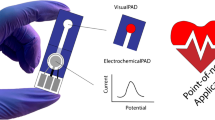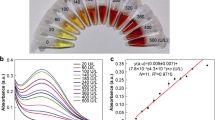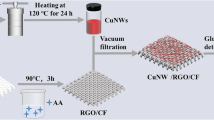Abstract
A method is described for surface-enhanced Raman scattering (SERS) discrimination of formaldehyde (FA) and acetaldehyde (AA) in aqueous sample solutions. It is based on the use of a paper strip containing 4-aminothiophenol (Atp)-modified reduced graphene oxide (rGO)/[Ag(NH3)2]+ (rGO/[Ag(NH3)2]+/Atp). The addition of FA or AA induces the conversion of [Ag(NH3)2]+ complex to silver nanoparticles (AgNPs) because of aldehyde-induced silver reduction reaction. The AgNPs possess strong SERS activity. The average interparticle gaps between the AgNPs can be fine-tuned by controlling the experimental conditions, this leading to the formation of optimized SERS hot spots. It is also found that the changes in the spectral shapes and the relative intensity ratio of the bands at 1143 and 1072 cm−1 result from the difference in the pH value of the surrounding solution. This effect enables the selective discrimination of FA and AA. The paper strip can be used as a SERS dipstick and swab for on-site determination of FA or AA in wine and human urine via the differences in the intensity of the SERS peaks. The assay works over a wide range of concentrations (0.45 ng·L−1 to 480 μg·L−1) for FA and AA, and the respective detection limits are 0.15 and 1.3 ng·L−1.

Schematic presentation of the preparation procedure of 4-aminothiophenol (Atp)-modified reduced graphene oxide (rGO)/[Ag(NH3)2]+ hybrid paper and its surface-enhanced Raman scattering discrimination of formaldehyde and acetaldehyde based on silver reduction.






Similar content being viewed by others
References
Zhang Z, Zhao C, Ma Y, Li GK (2014) Rapid analysis of trace volatile formaldehyde in aquatic products by derivatization reaction-based surface enhanced Raman spectroscopy. Analyst 139:3614–3621
Afkhami A, Bagheri H (2012) Preconcentration of trace amounts of formaldehyde from water, biological and food samples using an efficient nanosized solid phase, and its determination by a novel kinetic method. Microchim Acta 176:217–227
Srinath AK, Sankaranarayanan L, Pandeeswari R, Jeyaprakash BG (2015) Thin films of α-mn2o3 for resistance-based sensing of acetaldehyde vapor at ambient temperature. Microchim Acta 182:1619–1626
Hye-Seung J, Hyun C, Sang-Hoon S, Cho-Il K, Joon-Goo L, Young-Suk K (2015) Alidation and determination of the contents of acetaldehyde and formaldehyde in foods. Toxicol Res 31:273–278
Zhang D, Zhang J, Li M, Li W, Aimaiti G, Tuersun G, Ye J, Chu Q (2011) A novel miniaturised electrophoretic method for determining formaldehyde and acetaldehyde in food using 2-thiobarbituric acid derivatisation. Food Chem 129:206–212
Paiano V, Bianchi G, Davoli E, Negri E, Fanelli R, Fattore E (2014) Risk assessment for the Italian population of acetaldehyde in alcoholic and non-alcoholic beverages. Food Chem 154:26–31
Nagarajan V, Thayumanavan A (2018) Cdfe2o4 films for electroresistive detection of ethanol and formaldehyde vapors. Microchim Acta 185:319
Chi X, Tang Y, Zeng X (2016) Electrode reactions coupled with chemical reactions of oxygen, water and acetaldehyde in an ionic liquid: new approaches for sensing volatile organic compounds. Electrochim Acta 216:171–180
Yu Y, Zhang XM, Ma JP, Liu QK, Wang P, Dong YB (2014) Cu(I)-MOF: naked-eye colorimetric sensor for humidity and formaldehyde in single-crystal-to-single-crystal fashion. Chem Commun 50:1444–1446
Wang X, Si Y, Mao X, Li Y, Yu J, Wang H, Ding B (2013) Colorimetric sensor strips for formaldehyde assay utilizing fluoral-p decorated polyacrylonitrile nanofibrous membranes. Analyst 138:5129–5136
Han S, Wang J, Jia S (2014) Determination of formaldehyde based on the enhancement of the chemiluminescence produced by CdTe quantum dots and hydrogen peroxide. Microchim Acta 181:147–153
Iitani K, Sato T, Naisierding M, Hayakawa Y, Toma K, Arakawa T, Mitsubayashi K (2018) Fluorometric Sniff-Cam (gas-imaging system) utilizing alcohol dehydrogenase for imaging concentration distribution of acetaldehyde in breath and transdermal vapor after drinking. Anal Chem 90:2678–2685
Wang H, Ding J, Du X, Sun X, Chen L, Zeng Q, Xu Y, Zhang X, Zhao Q, Ding L (2012) Determination of formaldehyde in fruit juice based on magnetic strong cation-exchange resin modified with 2,4-dinitrophenylhydrazine. Food Chem 131:380–385
Lv ZY, Mei LP, Chen WY, Feng JJ, Chen JY, Wang AJ (2014) Shaped-controlled electrosynthesis of gold nanodendrites for highly selective and sensitive sers detection of formaldehyde. Sensors Actuators B Chem 201:92–99
Wang R, Xu Y, Wang R, Wang C, Zhao H, Zheng X, Liao X, Cheng L (2017) A microfluidic chip based on an ito support modified with ag-au nanocomposites for sers based determination of melamine. Microchim Acta 184:279–287
Deng Z, Chen X, Wang Y, Fang E, Zhang Z, Chen X (2015) Headspace thin-film microextraction coupled with surface-enhanced raman scattering as a facile method for reproducible and specific detection of sulfur dioxide in wine. Anal Chem 87:633–640
Li D, Duan HZ, Ma YD, Deng W (2018) Headspace-sampling paper-based analytical device for colorimetric/surface-enhanced Raman scattering dual sensing of sulfur dioxide in wine. Anal Chem 90:5719–5727
Gong MM, Sinton D (2017) Turning the page: advancing paper-based microfluidics for broad diagnostic application. Chem Rev 117:8447–8480
Yang Y, Noviana E, Nguyen MP, Geiss BJ, Dandy DS, Henry CS (2017) Paper-based microfluidic devices: emerging themes and applications. Anal Chem 89:71–79
Phansi P, Sumantakul S, Wongpakdee T, Fukana N, Ratanawimarnwong N, Sitanurak J, Nacapricha D (2016) Membraneless gas-separation microfluidic paper-based analytical devices for direct quantitation of volatile and non-volatile compounds. Anal Chem 88:8749–8756
Zeng J, Fan S, Zhao C, Wang Q, Zhou T, Chen X, Yan Z, Li Y, Xing W, Wang X (2014) A colorimetric agarose gel for formaldehyde measurement based on nanotechnology involving tollens reaction. Chem Commun 50:8121–8123
Cheng ML, Tsai BC, Yang J (2011) Silver nanoparticle-treated filter paper as a highly sensitive surface-enhanced raman scattering (SERS) substrate for detection of tyrosine in aqueous solution. Anal Chim Acta 708:89–96
Sun C, Chen T, Ruan W, Zhao B, Cong Q (2017) Controlling the orientation of probe molecules on surface-enhanced raman scattering substrates: a novel strategy to improve sensitivity. Anal Chim Acta 994:65–72
Li D, Duan HZ, Wang YH, Zhang QM, Cao HR, Deng W, Li DW (2018) On-site preconcentration of pesticide residues in a drop of seawater by using electrokinetic trapping, and their determination by surface-enhanced Raman scattering. Microchim Acta 185:10
Zhang C, Li C, Yu J, Jiang S, Xu S, Yang C, Liu YJ, Gao X, Liu A, Man B (2018) SERS activated platform with three-dimensional hot spots and tunable nanometer gap. Sensors Actuators B Chem 258:163–171
Yang T, Ma J, Zhen SJ, Huang CZ (2016) Electrostatic assemblies of well-dispersed AgNPs on the surface of electrospun nanofibers as highly active SERS substrates for wide-range pH sensing. ACS Appl Mater Interfaces 8:14802–14811
Li D, Jia SJ, Fodjo EK, Xu H, Wang YH, Deng W (2016) In situ SERS and X-ray photoelectron spectroscopy studies on the pH-dependant adsorption of anthraquinone-2-carboxylic acid on silver electrode. Appl Surf Sci 367:153–159
Kim K, Kim KL, Shin D, Choi JY, Shin KS (2012) Surface-enhanced Raman scattering of 4-aminobenzenethiol on Ag and Au: pH dependence of b2-type bands. J Phys Chem C 116:4774–4779
Kim K, Shin D, Choi JY, Kim KL, Shin KS (2011) Surface-enhanced Raman scattering characteristics of 4-aminobenzenethiol derivatives adsorbed on silver. J Phys Chem C 115:24960–24966
Adkins H, Elofson RM, Rossow AG, Robinson CC (1949) The oxidation potentials of aldehydes and ketones. J Am Chem Soc 71:3622–3629
Acknowledgements
We thank the support of the Natural Science Foundation of China (21507089, 21575041, 21777041), the Shanghai University Young Teacher Training Program (ZZyy15095), the Scientific Research Foundation for the Introduction of Talent of Shanghai Institute of Technology (YJ2015-6), Shanghai Pujiang Program (17PJD010) and Shanghai Municipal Education Commission (Plateau Discipline Construction Program).
Author information
Authors and Affiliations
Corresponding authors
Ethics declarations
The author(s) declare that they have no competing interests.
Additional information
Publisher’s note
Springer Nature remains neutral with regard to jurisdictional claims in published maps and institutional affiliations.
Electronic supplementary material
ESM 1
(DOC 36364 kb)
Rights and permissions
About this article
Cite this article
Duan, H., Deng, W., Gan, Z. et al. SERS-based chip for discrimination of formaldehyde and acetaldehyde in aqueous solution using silver reduction. Microchim Acta 186, 175 (2019). https://doi.org/10.1007/s00604-019-3305-0
Received:
Accepted:
Published:
DOI: https://doi.org/10.1007/s00604-019-3305-0




